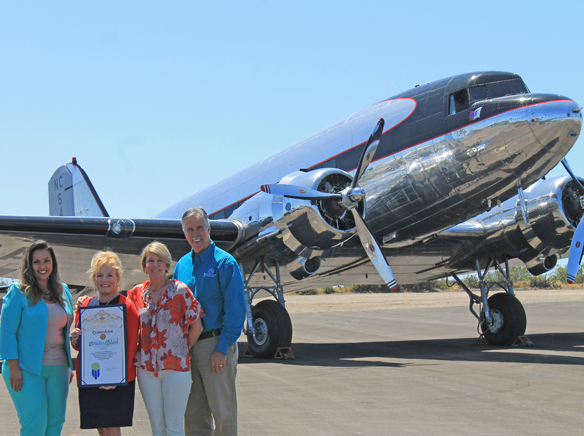
In a dramatic ceremony worthy of Catalina Island’s rich history, a vintage airplane carrying the daughter of William Wrigley III lumbered onto Ace Clearwater Airfield May 3 to commemorate its renovated runway and the completion of a historic public/private partnership.
Quite ironically, the airport refurbishing comes as Catalina celebrates its 100-year anniversary of the Wrigley’s massive investment in the island.
“The flight was fabulous,” said Alison Wrigley Rusack after she stepped off a DC-3 once owned by her family. Alison is the daughter of Wrigley and the granddaughter of Philip K. Wrigley, whose interest in aviation is legendary and who once owned the vintage airliner that was traced, repurchased and is now being restored by the family.
Top military brass awaited their arrival at Catalina’s Airport in the Sky while U.S. Marines and U.S. Navy Seabees actually lined portions of the nearly 3,200-foot runway in tribute.
Arriving exactly on time, the 1940s era plane performed a dramatic flyover before becoming the first to actually land on the newly resurfaced Runway 22.
The DC-3 was followed closely by a Tiger Squadron consisting of six Nanchang WW II era CJ6A planes flying in formation, and the air show was not limited to the field as both the DC-3 and the chase planes flew over Avalon in recognition of the island’s most populated city.
In another rare display of aeronautical history, a P-38 Lightning and a B-25 Mitchell performed a high-speed fly-by, but the planes were considered to be too rare to land.
According to the Conservancy, the DC-3 landing marked the culmination of a $5 million public/private partnership between the Conservancy and the Department of Defense, with the Marine Corps and the U.S. Navy rebuilding the runway as part of an Innovative Readiness Training project.
“We had some beautiful aeronautical moments here at the airport and are so appreciative of all of those who came today to celebrate this great accomplishment,” said Conservancy President and CEO Tony Budrovich as he brought the cheering crowd of about 200 people to order.
The management of the airport falls to the Conservancy since it is located within the 42,000- acre preserve, one of California’s oldest and the world’s best-known protected land trust.
The amalgamation of officials gathered for the ceremony included the U.S. Marine Corps, the U.S. Navy, the Caltrans Division of Aeronautics, and representatives of the U.S. Senate, House, State Senate, State Assembly and the city of Avalon.
“We had a wonderful experience working with the military from the first meeting to the end,” said Budrovich. “They showed exemplary service and capabilities and learned what it was like to work on Catalina. It’s a remote and sometimes difficult place to make things happen, but they had success. They stayed on schedule and did a fantastic job. We are so thankful for all of the partners that contributed to this project,” he added.
The project, start to finish, took about two years said Maj. Lisbeth M. Andriessen, overall manager of the U.S. Marine Corps Innovative Readiness Training, who said later that the Catalina airport “renovation” was the largest project every completed by active-duty Marines under the program (see related story).
More typically, she said, IRT projects are performed by reserve troops but the success of the runway will inspire others for active duty troops (see related story). Normally bogged down in paperwork, being out on Catalina seeing the ribbon cutting is the “best part of my job,” she said.
Units participating included I Marine Expeditionary Force (I MEF) out of Camp Pendleton, 3rd Marine Aircraft Wing (3rd MAW) and Marine Wing Support Squadron 373 (MWSS-373) out of Marine Corps Air Station Miramar, Naval Construction Group One (NCG1), First Naval
Construction Regiment (1NCR) and Navy Mobility Construction Battalion (NCMB-25).
Under the IRT program, the military supplies the manpower, engineering and equipment, while the community provides the project and any additional funding, Andriessen said.
Funding for this project came in the form of a donation from ACE Clearwater Enterprises and Budrovich acknowledged Kellie and Gary Johnson for a very generous gift to the Airport Runway Repair Project.
Budrovich said earlier “with their leadership and the generosity of so many others, we are well on our way to raising the funds needed to pay for repairing the runway.”
Acting Chief of the State of California’s Division of Aeronautics, Ron Bolyard, presented the official operating permit for Catalina Island Conservancy’s Airport in the Sky to Budrovich.
Budrovich, in turn, presented official landing certificate #001 to Alison Wrigley Rusack and Geoff Rusack, owners of the restored DC-3.
In recognition of the ACE Clearwater financial gift, officials also presented a duplicate of the certificate to the Johnsons, the project’s major benefactors.
Following the ceremony, Alison Wrigley Rusack and Killie Johnson cut the ribbon as the airport finally reopened to air traffic at 3 p.m.
The Catalina Island Conservancy was formed in 1972 with a mission of being a responsible steward of its lands through a balance of conservation, education and recreation. Through its ongoing efforts, the Conservancy protects the magnificent natural and cultural heritage of Santa Catalina Island, which includes more than 60 miles of rugged shoreline, access to the Island’s wildlands and 50 miles of biking and nearly 165 miles of hiking opportunities within its road and trail system.
The Conservancy conducts educational outreach through two nature centers, its Wrigley Memorial & Botanic Garden and guided experiences in the Island’s rugged interior. Twenty miles from the mainland, the Island is a treasure trove of historical and archaeological sites. It also contains numerous rare and endangered animals and plants. The Island is home to 60 species – and counting – that are found only on Catalina. Additional information is available at www.catalinaconservancy.org.










